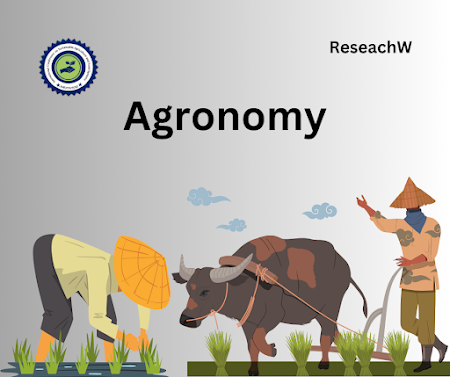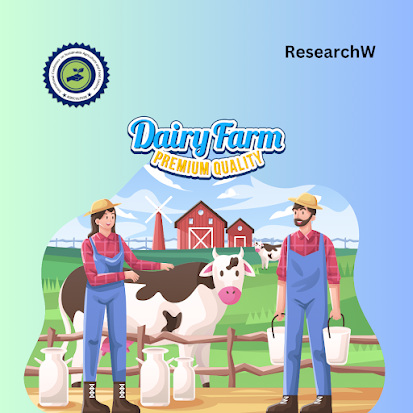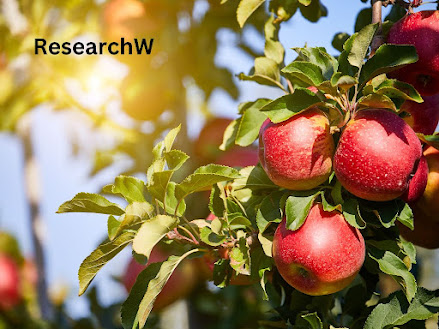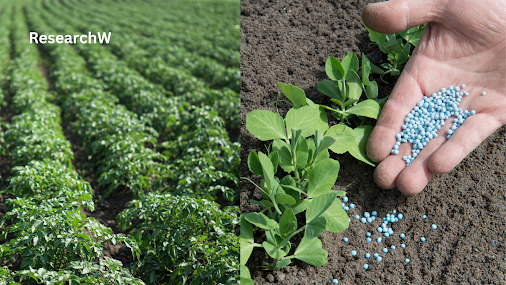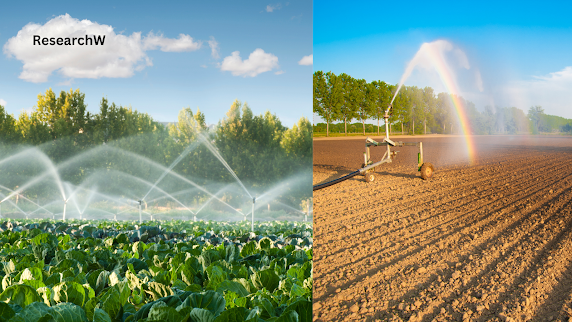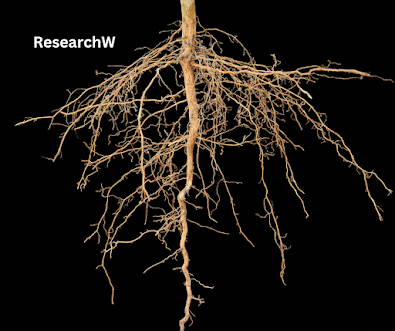Wednesday, 27 September 2023
Monday, 25 September 2023
Friday, 22 September 2023
Agronomy
Agronomy is a branch of agricultural science that focuses on the study and management of crop plants and their production. It encompasses a wide range of topics related to crop cultivation, including soil management, crop selection, planting techniques, crop nutrition, pest and disease management, irrigation, and overall crop production and improvement.
Agronomists, who are experts in agronomy, work to optimize agricultural practices to ensure sustainable and efficient crop production. They aim to increase crop yields, improve crop quality, and reduce the environmental impact of agriculture. Agronomy plays a critical role in addressing global food security challenges by developing and implementing techniques and technologies that enhance agricultural productivity.
#Agronomy: The general hashtag for all things related to agronomy.
#CropScience: Focuses on the science behind crop production and management.
#SoilHealth: Pertains to topics related to soil management and improving soil health.
Wednesday, 20 September 2023
Soil Fertility
Soil fertility refers to the ability of soil to provide essential nutrients to plants and support their growth and development. Fertile soil contains a balance of physical, chemical, and biological properties that make it conducive to plant life. Here are some key factors that contribute to soil fertility:
Nutrient Content: Fertile soil contains an adequate supply of essential nutrients such as nitrogen (N), phosphorus (P), potassium (K), calcium (Ca), magnesium (Mg), and trace elements like iron (Fe) and zinc (Zn). These nutrients are essential for plant growth and are typically derived from organic matter and mineral components in the soil.
#SoilFertility
#HealthySoil
#SoilHealth
#FertileSoil
#SoilNutrients
- Nomination Link: https://x-i.me/nomd1
Dairy Farming
Dairy farming is a branch of agriculture that involves the raising of dairy cattle and the production of milk and dairy products such as cheese, yogurt, butter, and cream. It is an essential component of the food industry and provides a significant source of nutrition for people worldwide. Here are some key aspects of dairy farming:
Dairy Cattle: Dairy farms typically raise specific breeds of cattle known for their milk production capabilities. Common dairy cattle breeds include Holstein, Jersey, Guernsey, and Ayrshire. These cows are selected and bred for their ability to produce large quantities of milk.
Milk Production: The primary goal of dairy farming is to produce high-quality milk. Dairy cows are milked regularly, often twice a day, using milking machines. The milk is then stored and transported to processing facilities.
Feeding and Nutrition: Proper nutrition is essential for dairy cows to maintain their health and milk production. Dairy farmers provide a balanced diet that includes hay, silage, grains, and supplements to ensure the cows receive the necessary nutrients.
Housing and Comfort: Dairy cows require proper shelter and comfortable living conditions. Many modern dairy farms have barns or facilities equipped with ventilation, temperature control, and bedding to ensure the well-being of the animals.
Health Care: Dairy cows require regular veterinary care to maintain their health. Farmers monitor their cows for signs of illness and provide vaccinations and treatments when necessary. Maintaining good herd health is crucial for milk production.
#DairyFarm
#MilkProduction
#FarmLife
#HolsteinCows
#JerseyCattle
Nomination Link: https://x-i.me/nomd1
Visit: https://x-i.me/SrzK
Tuesday, 19 September 2023
Friday, 15 September 2023
Apple Farming
Apple farming is the process of cultivating apple trees to produce apples for consumption and commercial purposes. Apples are one of the most popular and widely grown fruits in the world. Here are some key aspects of apple farming:
Selecting the Right Location: Apple trees require specific climate conditions to thrive. They prefer areas with cold winters and warm summers. Apples are grown in many regions worldwide, but some of the major apple-producing countries include the United States, China, India, and Poland.
Choosing Apple Varieties: There are thousands of apple varieties available, each with its own flavor, texture, and intended use. Farmers select the apple varieties that are best suited to their climate and market demands.
Preparing the Soil: Before planting apple trees, it's essential to prepare the soil. This involves soil testing to determine its pH, nutrient content, and drainage capacity. The soil should be well-drained and rich in organic matter.
Planting Apple Trees: Apple trees are usually planted as dormant, bare-root saplings in late winter or early spring. Proper spacing between trees is crucial to ensure adequate sunlight, airflow, and room for growth.
Caring for Apple Trees: Apple trees require regular care, which includes pruning, watering, fertilizing, and pest and disease management. Pruning helps shape the tree, promote fruit production, and improve airflow within the canopy.
#AppleFarming
#AppleOrchard
#AppleFarm
#FruitFarming
#FarmLife
Thursday, 14 September 2023
Manure
Manure is organic material that is used to fertilize soil and improve its fertility. It is a valuable resource in agriculture and gardening because it provides essential nutrients to plants and improves soil structure. Manure can come from various sources, including livestock, poultry, and even composted organic materials. Here are some key points about manure:
Types of Manure: There are several types of manure, each with its own nutrient content and characteristics. Common types include:
Animal Manure: This includes manure from animals like cows, horses, pigs, chickens, and goats. Different animal manures have varying nutrient profiles.
Green Manure: Green manure is made from fresh plant material, such as legumes or cover crops, that is plowed into the soil before it decomposes fully. It adds organic matter and nutrients to the soil.
Composted Manure: Manure that has undergone a composting process is more stable and less likely to contain harmful pathogens. Composting also helps eliminate odors.
Liquid Manure: Some manures are liquefied for easier application through irrigation systems.
Nutrient Content: Manure is rich in essential nutrients for plant growth, including nitrogen (N), phosphorus (P), and potassium (K). These nutrients are often referred to as NPK. The nutrient content varies depending on the type of manure and the animal's diet.
Organic Matter: In addition to nutrients, manure contains organic matter, which improves soil structure, water retention, and aeration.
Benefits of Using Manure:Fertilization: Manure provides a slow-release source of nutrients to plants.
Soil Improvement: It enhances soil structure and microbial activity.
Waste Reduction: Properly managing animal manure can reduce environmental pollution.
Sustainability: Using manure as a fertilizer promotes the recycling of nutrients in agriculture.
Precautions:Pathogens: Fresh manure may contain harmful pathogens, so it should be properly composted or aged before application.
Odor: Manure can produce unpleasant odors, which can be a concern in densely populated areas.
Nutrient Management: Overapplication of manure can lead to nutrient imbalances and environmental issues.
Application: When using manure as a fertilizer, it's important to follow recommended application rates based on soil testing and the specific nutrient needs of the crops you're growing.
Regulations: In many regions, there are regulations and guidelines governing the use of manure to minimize environmental impacts.
Overall, manure is a valuable resource in agriculture and can be an important component of sustainable farming practices when used responsibly and in accordance with best management practices.
#Fertilizer
#OrganicFertilizer
#Compost
#Gardening
Monday, 11 September 2023
Irrigation
Irrigation is the artificial application of water to land or soil to assist in the growth of crops and vegetation. It is a crucial agricultural practice that has been used for thousands of years to ensure the availability of water for plants in areas with insufficient or irregular rainfall. Irrigation systems are employed to control the distribution of water, ensuring that crops receive the right amount of moisture at the right time.
#FarmLife
#Agriculture
#WaterManagement
#DripIrrigation
Thursday, 7 September 2023
Root Rot
Root rot is a plant disease caused by various fungi, and it primarily affects the roots of plants. It is a common problem in both indoor and outdoor plants and can lead to significant damage or even death of the affected plants if not addressed promptly. Here are some key points about root rot:
Fungal Causes: Root rot is typically caused by various soil-borne fungi, with the most common being species from the genera Phytophthora, Rhizoctonia, and Fusarium. These fungi thrive in wet and poorly drained soil conditions.
Symptoms: The symptoms of root rot can vary depending on the plant species and the severity of the infection. Common symptoms include wilting, yellowing of leaves, stunted growth, and a general decline in the health of the plant. As the disease progresses, the roots become discolored, mushy, and eventually decay.
Environmental Factors: Root rot is often triggered by excessively wet or poorly drained soil. Overwatering, heavy rainfall, or inadequate soil drainage can create conditions favorable for the growth and spread of the root rot fungi.
Prevention: Preventing root rot is typically more effective than trying to treat an infected plant. To prevent root rot:Ensure proper soil drainage by using well-draining potting mix or amending garden soil with organic matter.
Avoid overwatering. Allow the top inch or two of soil to dry out between waterings.
Provide good air circulation around the plant, as stagnant air can promote fungal growth.
Choose plants that are resistant to root rot if you have a history of the disease in your garden.
#RootRot
#PlantDiseases
#GardenProblems
#PlantCare
#GardenHealth
Assessing Rainwater Risks & Harvesting Solutions for Indonesia’s New Capital City | Sustainable Water Future
Introduction The development of Indonesia’s new capital city brings both opportunities and challenges in managing water resources. Rainwa...
